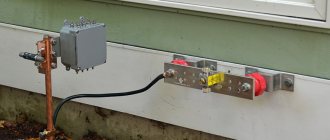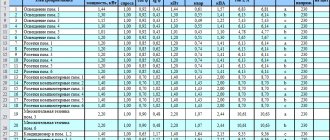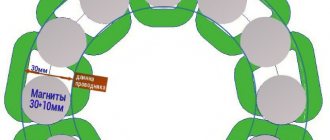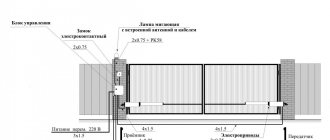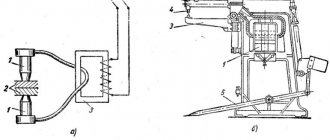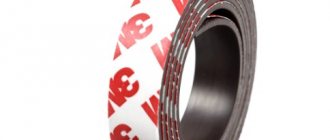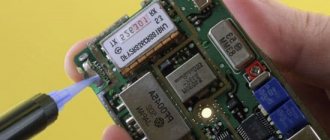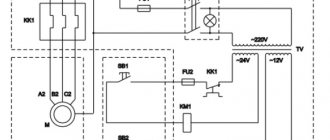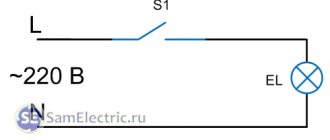TYPES AND TYPES OF INSTALLATION
An alarm loop (AL) is an electrical circuit containing:
- sensors (DS);
- connecting wires;
- terminal (OU), switching, as well as loop control devices (LCD).
This is the definition for a wired loop, and Figure 1 shows block diagrams of the most common options.
I would like to draw your attention to the ambiguity in the interpretation of the state of dry contacts (relays) in the “classical” technical understanding and use for security alarm systems. It would be correct to call the contacts normally closed (NC) for a device that has them closed when not in use. For normally open (NO), naturally the opposite is true.
For some reason, alarm sensors (detectors) are considered to be in a closed state when the detector is turned on. Indeed, when the detector is turned on and goes into the “normal” state, the contacts close, but this is a working state, which means they must be considered NR. In order to avoid confusion, it is better to look at how the alarm signal is generated:
- opening;
- or by closing relay contacts.
The vast majority of sensors use the first option (Fig. 1a). I dwell on this in such detail so that you understand the principle of operation of the alarm loop and the security system as a whole.
Watch the video
In the security mode, which is characterized by the supply of supply voltage to the detectors and the absence of influences causing the sensor to enter an alarm state, the AL is a closed circuit.
For the control panel (RCD), this is evidence that everything is normal at the controlled object. The control panel monitors the current flowing through the loop and if its value deviates upward or downward, it generates an alarm signal.
In order to provide the required current value, a terminal device is included in the loop - usually a resistor. Terminal devices may consist of other elements or combinations thereof, but this is not typical for most security systems.
By the way, the passport for the control device must indicate which element is used as the terminal element.
In order for current to appear in the loop, voltage must be applied to it. The PKP does this. Its terminal block indicates the polarity of the connection, which sometimes needs to be taken into account - more on that later.
Let's see in what cases the security alarm loop can open.
- as a result of an impact on the sensor, causing it to go into an alarm state;
- loss of supply voltage to active detectors;
- break or short circuit of the electrical circuit.
The first mode indicates intrusion detection (except in cases of false alarms). The other two are the result of various components of the alarm system malfunctioning. By the way, if sensors are used that generate an alarm signal by closing the contacts (Fig. 2b), then in the “alarm” mode the loop will be closed.
Technical characteristics of ShchR, ShR, ShRS:
Shock current withstand:
- at a rated cabinet current of 250A, at least 10kA;
- at a rated cabinet current of 400A, at least 25kA.
The scope of application of ShR and ShRS cabinets are power and lighting installations in industrial, residential, administrative, public buildings and other facilities. Distribution boards are designed to protect AC electrical installations with voltages up to 600V and frequency 50Hz during overloads and short circuits. With its help, you will also be able to ensure prompt switching on or off of electrical consumers in the future. Distribution boards can be actively used for industrial enterprises.
The main electrical panels include:
- board - main distribution board. It is this that receives power from transformer points or substations. It is equipped with automatic switches to protect outgoing lines, meters, and measuring instruments.
- ASU – input switchgear. Electricity is supplied from the main switchboard through switching devices to the switchboard, which is mounted at the entrance to a separate building or entrance. Just like the main switchboard, it is equipped with protection, measurement equipment, etc. Very often in small houses they make do with one of these types of electrical panels.
- ShchSN is a special electrical panel for providing electricity to the electrical installation’s own needs. Such a shield is powered by separate TSN transformers, usually using ATS (automatic transfer switch). ShchSN is needed to power heating of buildings and equipment, ventilation, lighting, winding springs of switches, etc.
- ATS is a certain type of electrical panel for protection against power loss at important facilities. When the voltage on the supply line disappears, the ATS device turns off the input circuit breaker of this line and turns on the backup input. Usually the reserve receives power from another point or substation. This is especially true for power supply to hospitals or enterprises of special importance.
- supply (DC) is an electrical panel that is designed to power devices and protection devices, automation, interlocks and equipment control. To convert alternating current into direct current, rectifiers, batteries, and converters are used.
Compound:
The design features are that the panels can be produced in a floor-mounted or wall-mounted version. The choice of a specific option will depend on the characteristics of the room in which the installation will take place in the future. Today, shields are manufactured in metal or plastic versions. The electrical panel may also include:
- Circuit breakers.
- Contactors.
- Load switches.
- Differential machines.
- RCD
What is an electrical panel?
This is a steel or plastic box in which equipment for inputting, accounting for quantity and distributing electrical energy consumption among sources is mounted. This is a necessary and mandatory attribute of the energy network. Another function of the metering and distribution board (MAB) is to protect operating personnel and equipment, as well as ensure safety from:
- threats of electric shock;
- fire caused by ignition of wires;
- short circuit in the electrical circuit.
What does an electrical panel consist of?
The device kit consists of standardized instruments, fastening devices and other parts. The electrical distribution panel consists of:
- mounting base (back wall of the panel);
- casing with lid (easily installed on the base);
- DIN rails (equipment is mounted on them);
- upper and lower insulators for zero busbars;
- input load switch;
- electricity meter;
- voltage relay;
- automatic circuit breaker (RCD);
- differential switch;
- blue (cyan) neutral wire;
- yellow-green protective ground wire;
- power phase wires (any other color);
- sockets
ShchR 1 UHL4
Elements on the diagram:
| Designation | Name |
| QF1 | Auto. switch (3 ph) up to 63 A |
| QF2-QF7 | Auto. switch (1 ph) up to 25 A |
| A1, A2 | RCD (1 f) up to 40 A |
In order to buy ShR, ShchR, ShRS you must indicate:
- type of instalation
- Cabinet material and IP
- Data on the entire technical load of consumers
- From which company components should I assemble?
TYPES AND TYPES OF SIGNALING LINES
Loops can be classified according to several criteria, for example:
- method of connection to the device;
- types of detectors used.
In the first case, two types can be distinguished: radial (Fig. 2a) and annular (Fig. 2b). The latter is quite rare and is used mainly in addressable fire alarm systems.
If we talk about the types of sensors used, then we can talk about threshold loops (Fig. 1a-b), which sharply change their electrical parameters when switching to the “alarm” mode, and address ones (Fig. 1c).
I have already talked about the first ones, but let’s look at addressable alarm loops now.
They are called so due to the addressable alarm sensors they use. In this case, information about the state of the sensor (in digital form) is transmitted over one two-wire line and the supply voltage is supplied. Due to the unique address, each detector can be uniquely identified by the system.
In this case, when connecting the loop, observing the polarity indicated on the terminals of the control panel and security sensors is mandatory. In addition, the number of detectors connected to the addressable alarm loop is limited and is determined by the technical characteristics of the device.
Price of distribution boards ShR, ShchR, ShchRS.
Below I would like to give you an example of the calculation and price of distribution boards. This assembly was made on the middle price segment of equipment from our domestic KEAZ (Kursk Electrical Apparatus Plant).
| Unit change | Qty | Price with VAT | |
| ShchR-1 | PC. | 1 | 31 259,62 |
| Mounted distribution board ShchRN-60z IP31 with lock (30208DEK) | PC. | 1 | |
| Load switch VN-32-363-UHL3 (141640) | PC. | 1 | |
| Single-pole automatic switch 16A S VM63 6kA (103545) | PC. | 3 | |
| Single-pole automatic switch 10A C VM63 6kA (103543) | PC. | 1 | |
| Automatic differential switch RCBO OptiDin D63-22C16-A-UHL4 with overcurrent protection (103507) | PC. | 18 | |
| Bus for DIN rail in housing (cross-module) 3L+PEN 4x11 | PC. | 2 | |
| Kit of mounting parts | PC. | 1 | |
| ShchR-2 | PC. | 1 | 22 010,23 |
| Mounted distribution board ShchRN-60z IP31 with lock (30208DEK) | PC. | 1 | |
| Load switch VN-32-363-UHL3 (141640) | PC. | 1 | |
| Single-pole automatic switch 16A S VM63 6kA (103545) | PC. | 1 | |
| Single-pole automatic switch 10A C VM63 6kA (103543) | PC. | 2 | |
| Automatic differential switch RCBO OptiDin D63-22C16-A-UHL4 with overcurrent protection (103507) | PC. | 11 | |
| Bus for DIN rail in housing (cross-module) 3L+PEN 4x11 | PC. | 2 | |
| Kit of mounting parts | PC. | 1 | |
| ShchR-3 | PC. | 1 | 21 500,00 |
| Mounted distribution board ShchRN-60z IP31 with lock (30208DEK) | PC. | 1 | |
| Load switch VN-32-363-UHL3 (141640) | PC. | 1 | |
| Single-pole automatic switch 16A S VM63 6kA (103545) | PC. | 3 | |
| Single-pole automatic switch 10A C VM63 6kA (103543) | PC. | 2 | |
| Automatic differential switch RCBO OptiDin D63-22C16-A-UHL4 with overcurrent protection (103507) | PC. | 11 | |
| Bus for DIN rail in housing (cross-module) 3L+PEN 4x11 | PC. | 2 | |
| Kit of mounting parts | PC. | 1 |
Types of electrical panels
They differ in purpose, installation method, and material. Depending on the purpose of application, they are divided into:
- Main distribution board
(MSB). Serves for input and metering of energy into a large object (group). Receives energy from power lines, transformer stations or individual transformers. - Input switchgear
(ISU). It can perform similar functions of the main switchboard, or serve to further supply power to smaller objects. Measuring instruments that monitor current parameters are additionally installed in it. - Emergency commissioning of reserve
. This electrical panel automatically switches to backup power sources in the event of an emergency. The latter can be batteries and transformer substations. - Floor electrical panel
(SHB). Installed on the floors of buildings in specially designated areas. Carries the functions of further distribution of energy throughout the floor. - Apartment panel
(AS). Can be installed both inside apartments and on the floor. This electrical panel is responsible for powering residential areas, accounting for electricity consumption and protecting against the negative effects of electric current. - Lighting board
. It is used as a separate device to provide on/off functions for lighting devices. - Control and automation panels
. The panel for electrical circuit breakers is mainly used in electrical installations, power plants, and substations. Often control and automation functions are combined.
Mounted electrical panel
Manufactured in various depths (side wall width). They are designed for installation on a wall, a special device or a support. For the manufacture of a non-separable body, sheet steel 1 mm thick is used. The rigidity of the structure ensures reliable installation of the equipment. An apartment electrical panel can be made of plastic and have a collapsible body, consisting of a rear wall (mounting base) and a casing with a lid. They are connected to each other with special fasteners. When the cabinet height is up to 800 mm, the panels are equipped with one lock, above - two.
Built-in electrical panel
Designed for installation deep into the wall. Comprises:
- body made of steel 1 mm thick;
- steel mask with a door hung on it.
The housing has technological holes for wall mounting. Powder painting is carried out in an electrostatic field. To install internal equipment, mounting panels or modular systems are used. The electrical panel in an apartment of this type has the ability to change the door opening. The generally accepted wall installation depth is 120 mm. Internal protection degree IP31.
Floor electrical panel
Can serve as a main board for power input and distribution. A welded frame made of 2 mm thick steel provides rigidity to the structure. The filling consists of removable components and assemblies assembled linearly. It can have either one or two doors. The locking device can block the door in 4 places. At the installation site it is mounted on a special base. An electrical panel in a private house, located outdoors, is equipped with increased protection from the influence of the external environment, type IP55, 65.
